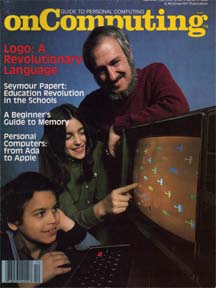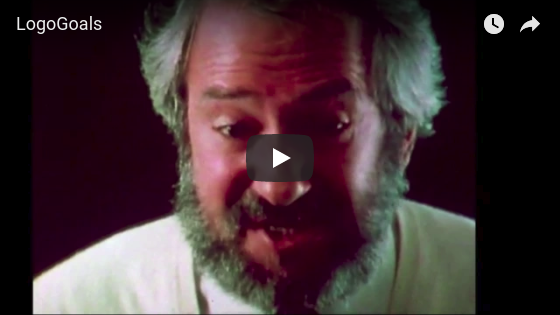logothings
#The 80s
My View of Logo, Papert and Constructionist Learning

Logo started at Bolt, Beranek and Newman, a research complany in Cambridge Massachusetts. Danny Bobrow who had been a doctoral student of Marvin Minsky and Seymour Papert was head of the Artificial Intelligence Group. He introduced Seymour to Wally Feurzeig, woho was in charge of a couple of education projects, and Seymour began to consult on Wally’s school project. I joined Wally’s group using Lisp to build a teaching system for medical students.
The school project involved 5 classes, high school, junior high, and elementary. The students were using Telcomp a language similar to Basic except it was an interpreter. Seymour visited several classes and was particularly struck by the absurdity of students using an algembraic programminb language to learn algebra. He declared that children needed a language designed for them. And so Logo was invented. The idea was borne in 1966 and Logo was ready for kids in 1967.
Seymour taught a summer workshop to a group of 5th graders. Wally and I observed. I took copious notes and gave Seymour daily feedback. Logo was totally redesigned. In 1968-69 Seymour and I co-taught a group of 7th graders. At the end of te year Seymour declared we needed turtles!
I joined Seymour at MIT where he was a professor in the Applied Math Department. The Logo Group as part of the MIT Artificial Intelligence Lab was started. I have pages here: The60s, The70s, The80s, Apple, Logo Atafi Cambridge Research.
Here Seymour talks about Logo and Basic.
Seymour articulates the goals for Logo the language.
Papert and Talking Turtle
Talking Turtle is a 1983 video made by the Open University and the BBC. The video captures Papert’s thinking about learning and Logo and turtles. Talking Turtle shows children actively engaged. The video was sent to me by Russell Warfield in Australia. Here is an excerpt.
Here is the entire video broken up into five pieces.
An Experiment in Constructionism: Dance and Computing
As Talking Turtle illustrates, Papert was interested in engaging the whole child in the Mathland offered by Logo. Twenty years later in 2003 he continued to pursue this integration.
Seymour Papert with Jacques d’Amboise and their gangs of people set up a stage with sensors to control sound, lights and animations at the MIT Media Lab in the summer of 2003. Children were to learn and invent dances that they would coordinate with music, lights, and action.
Here are some slides of the children.
You can learn more about this project here and see the children in rehearsal here.
Why this Wiki?
I started this wiki because of Seymour Papert’s accident and because I had begun work on another wiki containing example Logo projects including video tutorials, images, and text. It got me thinking about the past. I encourage contributions and have set up space in this wiki for other people’s contributions. (See Logo.Adventurers.) You are welcome to add to that page or create a new one.
In looking for early records of the past I found very few pictures and videos, but posted what I had. (We mostly had taken screen images.) Although I started Logo with Seymour Papert and Wally Feurzeig at the research lab of Bolt, Beranek and Newman around 1966, I have absolutely no pictures from that time. I did find a few from the early 1970s. Here are Marvin and Seymour in 1971.

I also found a video I made in 1984 when the Atari Cambridge Research lab closed. I’ve split the video, which shows Logo-based research conducted from 1982 to 1984 at Atari Cambridge Research, into seven clips.
This wiki is an experiment in collecting and presenting material on Logo.
Logo, the Language
The Logo language went through several iterations; four or five by
- The MIT version culminated in a dedicated Logo environment running on a Digital PDP-11 with special turtle graphics stations which we showed at a math education conference in Exeter, England. It was the summer of 1972 and a group of us including Hal Abelson, Ron Lebel, Tom Knight, Margaret Minsky, and Erric Solomon went with the equipment four weeks before the conference. We set up Logo classes working with Exeter kids. Jeanne Bamberger and Seymour joined us a week before the conference. (Ron Lebel was the major hardware and software person. He chose to adapt Tom Knights graphics stations for the MIT AI Lab to this dedicated Logo system. Of course, Hal Abelson was involved as were a number of us in the language specifications. Each new implementation gave the Logo Group a chance to review and revise the language.) I always thought it was especially helpful that during the first few years Logo was not widespread and thus could go through several transformations.
In the 70s there were several new implementations which took into account new hardware capabilities. These included General Turtle’s Logo for stand alone workstations, Logo for the Apple II, TI-Logo, and so on. Logo for the Texas Instruments 9900 (?) took advantage of the special TI hardware which provided sprites. Now, you not only had color (introduced by the Apple version) you had more than one turtle.
The First Year-Long Class
Our first full year Logo class was in 1968-69 with seventh graders at Muzzey Junior High School. We were at BBN at the time. In the fall of 1969 I became a member of the AI Lab and we started our Logo work there.
The first graphics turtle and a floor turtle were built and running by
- The graphics turtle was not portable. Its display was driven by a Digital PDP-6 connected to a Logo running on the lab’s PDP-10. First programs were written by Bill Gosper and other lab hackers. The yellow turtle was assembled by Tom Callahan.
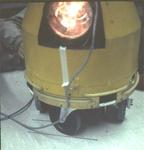
In preparation for using turtle graphics with kids Seymour began planning a portable system. This is when Hal Abelson joined the group. He started the design and worked with Nat Goodman on getting the software to work.
Marvin designed and built a four voice music box for us. It was housed in a small black translucent plastic box.
Pictures from the Bridge School in Lexington, MA – 1970-2
We were given 2 small rooms with a large window between them. The graphics turtle ran on a display powered by a Data General computer. The children used Logo over phone lines to a time-shared Digital PDP-10 back at the MIT AI Lab.

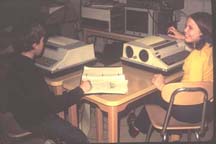
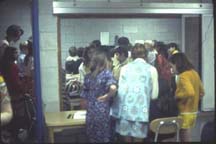
5th graders with our first turtle.
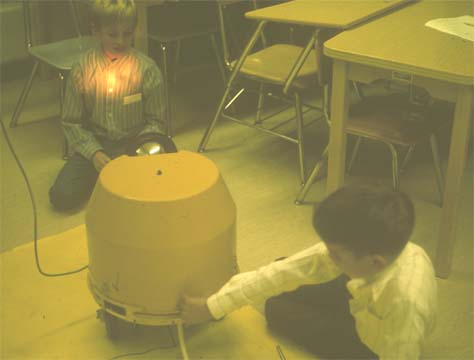
Seymour in the classroom


Me with kids.
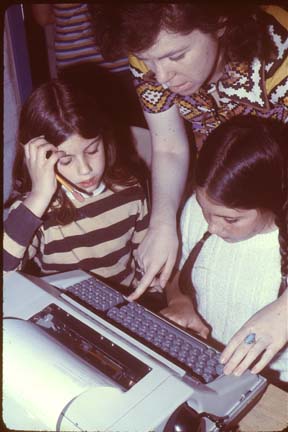
Teaching Assistants
Kiyoko Okumura, Rich Fryberg and Bob Mohl
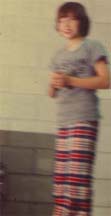
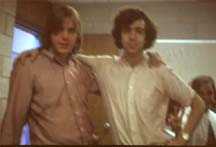
Turtle Graphics Ramblings


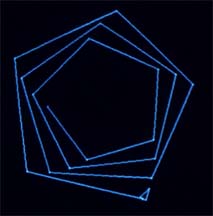
Our second turtle
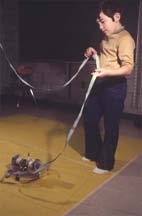

Work with Young Children
Radia Perlman’s Button Box for Pre-Schoolers
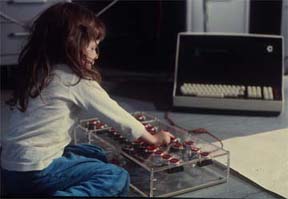
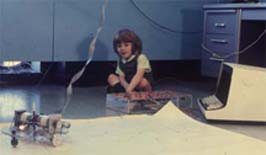
Me with First Graders in 1971-2
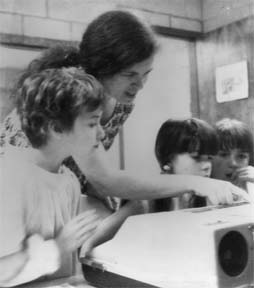
1972 Logo Re-implementation
In time for an international math education conference held at the university in Exeter, England, Ron Lebel had led the implementation of Logo on a dedicated time-shared DEC PDP-11. This time shared system included “portable” turtle graphics stations based on Tom Knight’s display stations running on the AI Lab’s PDP-10. Hal and Nat were involved in the graphics. The language revisions were major and were based on feedback from work with children. DEC helped us in shipping equipment and setting up in Exeter four weeks before the converence. The computer would stay at the university but the graphics stations (5), floor turtle, and music box were returned to MIT at the end of the conference. Several of us went over with the computer. The group included Ron Lebel, Tom Knight, Hal Abelson, Margaret Minsky, Erric Solomon and me. I went to work with 9, 10, 11 and 12 year old Exeter children. Margaret, a high schooler, was my teaching assistant and Erric, a middle schooler, joined the Exeter children. Jean Bamberger came over later to use the music box with the children. Seymour.also arrived a few days before the conference. We were given a large room in close proximity to the conference rooms. The kids became teachers to the math educators attending the conference. The kids were incredible. Rumors spread such as Seymour could teach anybody anything. When it was discovered that I did the teaching, the rumors changed to we bribed the kids with candy.
General Turtle
Something else happened that summer. Marvin, Seymour, and I along with Russell Noftsker and Seymour’s brother Alan planned to make turtles available through a new company called General Turtle.
Later that year Marvin began designing a “portable” turtle graphics Logo station known as the 2500.
During the decade of the 70’s Logo went through several re-designs and re-implementations and new classroom teachings. There were three major projects that took place: the Brookline Project at the Lincoln School where Dan Watt taught the Logo classes; the Lamplighter School in Texas where TI Logo was tested out, and the Hennegan School project in Boston. There was also the wonderful work of Jose Valente (also Sylvia Weir and her team, Ann and Sue )with physically challenged and learning disabled students at the Cotting School. Also, during the 70s Howard Austen made a study of juggling as his doctoral work. This circus art Seymour and I taught children as an example of recursion. We also included bongo boarding and unicycling. (Seymour tried balancing on a circus ball.) In the later 70s a group of MIT students became part of the Logo Group. This included Margaret Minsky, Danny Hillis, Gary Drescher, Jim Davis, Ed Hardebeck, Brian Silverman, Max Behensky and more. They were housemates.
TI Logo
One of the founders of Texas Instruments, an MIT graduate, tapped Seymour to make a Logo for the TI “micro” computer under development. The new machine introduced the sprite hardware allowing for multiple turtles. Ed and Gary were deeply involved in this implementation with help from the others.
Celebrating TI Logo in 1981
